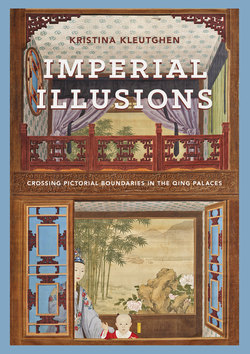Читать книгу Imperial Illusions - Kristina Kleutghen - Страница 21
На сайте Литреса книга снята с продажи.
Оглавлениеsometimes inscribed on smaller related works, or else simply recorded as part of the emperor’s writings. Linking scenic illusions to Qianlong’s poetry and the portable paintings that make up the majority of Qing court commissions helps break down the artificial divisions found in most scholarship between portable paintings and wall paintings.21 More importantly, rather than treating scenic illusions as isolated entities, retaining this link engages them as part of the larger body of works alongside which they were originally produced and that often influenced them.
Appealing to Sight and Touch
Standing in front of Spring’s Peaceful Message, Qianlong could not but have appreciated just how much the illusion created a garden where there was only a wall and extended the perceived space of the entire Hall of Mental Cultivation. Walls and bodies are two of the most complex and significant boundaries in Chinese culture.22 To diminish both of them simultaneously, all scenic illusions use adaptations of European illusionistic painting techniques and depth cues to visually replace walls with spaces and objects that appear to exist tangibly in three dimensions. In order for a viewer to understand a two-dimensional picture (a painting) as a projection of three-dimensional space (reality, or at least the illusion of it), he or she must interpret numerous visual cues in the picture as representing distance and depth in the real world. To create this effect, painters use a variety of depth cues, including
linear perspective (to suggest deep spatial recession);
foreshortening and angular distortion (so objects appear to project or extend
into space);
occlusion (an object that occludes another is probably in front of it);
size constancy (of two objects of presumed equal size, the smaller is farther
away);
resolution (fewer visible details indicate distance);
contrast (objects with less light and shadow contrast are likely farther away);
color (hue changes on comparable objects suggest the darker object is farther
away);
shadows (the position, distortion, and shape of shadows indicate relative
location);
reflectance and scattering (the amount of reflected or scattered light varies
relative to light source and viewer).23
With such depth cues employed in them, scenic illusions do not constitute a failure of normal perception; rather, they result from perfectly normal perceptual capabilities functioning as they should, but producing a nonstandard percept.24 The responses of
